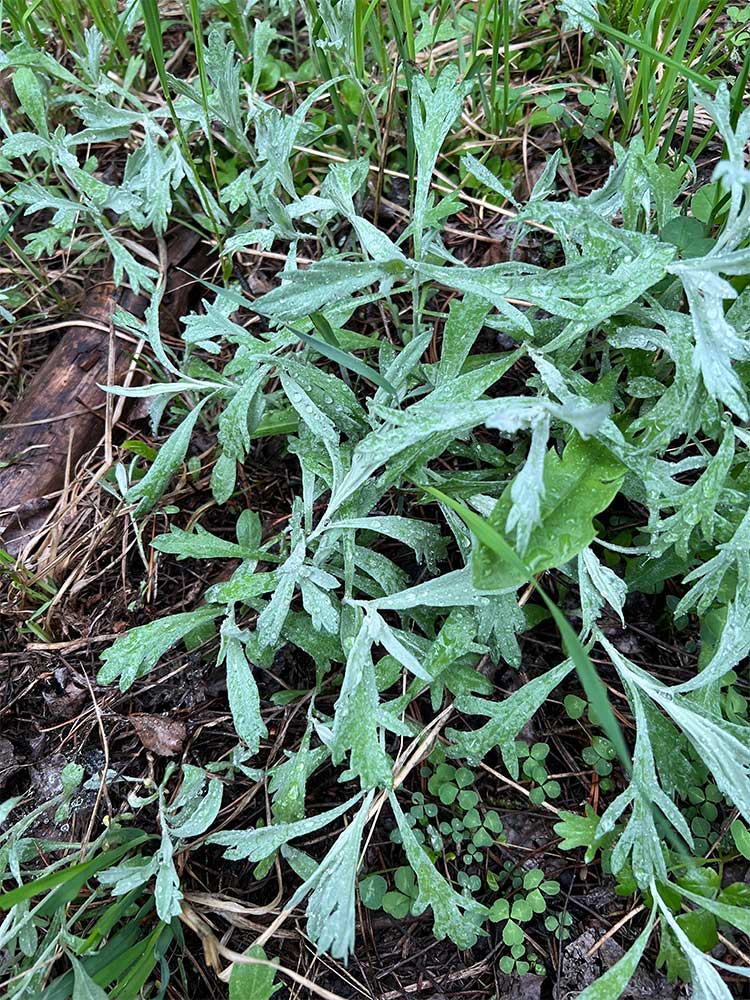Artemisia ludoviciana / white sage
- low, spreading perennial – up to 3 feet tall
- silvery leaves and stems (hairy)
- leaves lance shaped, but sometimes lobed
- shoots die back in winter
- aromatic
Also known as: silver wormwood, western mugwort, Louisiana wormwood, white sagebrush, lobed cud-weed, prairie sage, gray sagewort
Artemisia ludoviciana (the specific name being a Latinized version of Louisiana) is a rhizomatous perennial growing to between 1 and 3 feet tall. It often occurs in dense, pure stands up to 10 feet in diameter, with all the shoots connected by rhizomes. Vegetative reproduction is common even though seeds are also produced. Complicating this somewhat, the shoots die back at the end of the season. Thus, the total aboveground biomass at the end of a season is equivalent to the total growth for the season.
In summer and early fall, the stems may be topped by a narrow raceme inflorescence of nodding flower heads. The flowers are yellow but very small, yea teeny… less than 1/8″ across. The flower clusters aren’t much bigger. Like other Artemesias, ludoviciana produces a lot of flower stalks. Pollination occurs both by selfing and by wind.
White sage leaves may be silvery green or bright white, being covered in fine, white hairs. Sometimes, the upper surfaces are more green and the lower more white. Leaves get up to 5″ long and 1″ wide, on the best sites. As for shape, it’s pretty variable (as opposed to, perhaps, “highly” variable). In all cases, they are simple, i.e. not separated into leaflets, and lack petioles. But they may be either lobed or unlobed. The latter is the more common version. Lobed leaves are more common lower on the stems. Unlobed leaves are lanceolate, tapering to a sharp tip. The edges of the blades may have small lobes, teeth, either, both or neither.
Most of the roots are shallow, <5″ deep, although a few may go much deeper. In some cases the roots are colonized by mycorrhizal fungi. Unlike the response of many plants to this, colonization results in smaller plants overall.
Like other members of the genus, white sage is highly aromatic, resembling the more common big sagebrush.
White sage is found on dry slopes, and in canyons, open pine woods, dry prairies, and roadsides and borrow ditches. It likes “medium” moisture. In all cases, it only thrives in full sun. With adequate moisture on great sites, plants may be more strongly rhizomatous and form colonies up to 50 feet in diameter. This doesn’t seem to happen in the Valley.
interesting bits: Like other Artemisias, white sage has numerous secondary compounds that have long been exploited for medicinal purposes as well as for making household items and for ceremonial purposes. Being a native to North America, most of these were discovered by various indigenous peoples. Uses ranged from smudging rituals (Dakota people), to culinary uses (as spices… by the Apache, Chiricahua and Mescalero peoples) to dermatological salves (Blackfoot and Gros Ventre). As a tea, the Meskwaki and Potawatomi use it to treat sore throats and tonsillitis.
Note, however, that like other healing herbs, this plant is toxic in excessive doses.
Because of its traditional uses, white sage has received considerable attention from research scientists. The National Library of Medicine currently lists more than 120 articles relating to medicinally important (or potentially important) compounds in this species. The Roots of Medicine group at the University of Iowa also summarizes a number of studies on the anti-fungal properties of white sage extracts.
With the normal caveats about putting things in your mouth, both the leaves and flowers are said to be edible.
| Color | |
|---|---|
| Family | |
| Blossom size | |
| Inflorescence size | |
| Inflorescence type | |
| When? | |
| Where? |




